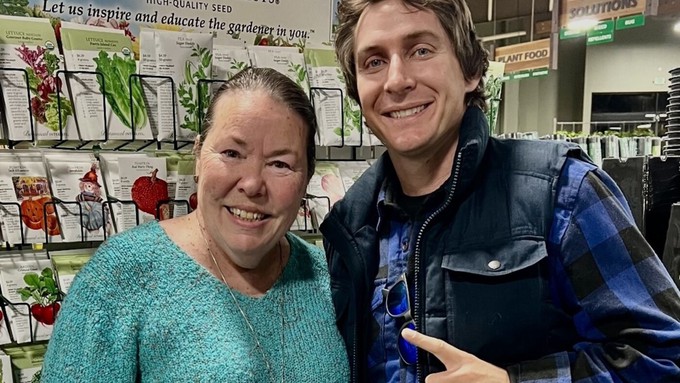
Debbie joins Green Acres Garden Podcast to share how to use fall harvest

Debbie Arrington of Sacramento Digs Gardening and Kevin Jordan of the Green Acres Garden Podcast recently chatted about cooking what you grow. Courtesy Green Acres Nursery & Supply
When I joined Kevin Jordan and Austin Blank for the Green Acres Garden Podcast, we talked at length about a common topic for food gardeners: Making use of your harvest. In other words, you grew it; now eat it.
Every backyard farmer knows that lament, heard most often during zucchini season or weeks after an enthusiastic planting spree. To me, it also echoes in my head when it’s time to harvest something I tried growing for the first time, such as some very pretty melons or unusual Asian greens.
What we grow very directly inspires what we cook. Our readers see that every Sunday in the selection of recipes that Kathy Morrison and I create for Sacramento Digs Gardening. Our three seasonal e-cookbooks are packed with dozens of examples of cooking what’s in season – and in abundance.
Before you plant, it helps to have some suggestions of what to do with the product of your gardening efforts. Our most recent e-cookbook, Taste Fall!, has more than 60 seasonal recipes using what we’re harvesting now – more than 30 different fruits and vegetables.
But our Taste Spring! e-cookbook has just as many ideas for how to use the vegetables you’re likely growing or planting right now.
What to do with your harvest – now and for harvests to come – is the basis of a project Sacramento Digs Gardening is now working on with our friends at Green Acres Nursery & Supply. We plan to provide easy links to our recipes at point of plant or seed purchase. (More on that to come.)
Episode No. 99 in the Green Acres podcast series, “Fall Recipes from the Garden,” focuses on using our bountiful fall harvest. For me, that’s a bumper crop of Fuyu persimmons and apples.
Also an avid food gardener, Kevin teaches gardening and a lot more at Leo A. Palmiter Jr./Sr. High School; he’s nursery and landscape instructor for the school’s Sustainable Environments Learning Academy. He was honored by the Sacramento Office of Education as the 2023 Teacher of the Year.
For this podcast, we had a great (and much longer) conversation about gardening and recipe ideas. Austin worked his editing magic to get it to fit into 28 minutes.
Listen to it here: https://www.buzzsprout.com/1610311/14021958-fall-recipes-from-the-garden
Find our TasteFall! E-cookbook here (it’s free!): https://sacdigsgardening.californialocal.com/article/60135-taste-fall-recipes-from-your-garden/
New podcast are posted every Friday. For past podcasts: https://www.buzzsprout.com/1610311.
More on Green Acres and what’s ready to plant now: https://idiggreenacres.com/.
Comments
0 comments have been posted.Sacramento Digs Gardening to your inbox.
Food in My Back Yard Series
May 6: Maintain soil moisture with mulch for garden success
April 29: What's (already) wrong with my tomato plants?
April 22: Should you stock up on fertilizer? (Yes!)
April 15: Grow culinary herbs in containers
April 8: When to plant summer vegetables
April 1: Don't be fooled by these garden myths
March 25: Fertilizer tips: How to 'feed' your vegetables for healthy growth
March 18: Time to give vegetable seedlings some more space
March 11: Ways to win the fight against weeds
March 4: Potatoes from the garden
Feb. 25: Plant a fruit tree now -- for later
Feb. 18: How to squeeze more food into less space
Feb. 11: When to plant? Consider staggering your transplants
Feb. 4: Starting in seed starting
Sites We Like
Garden Checklist for week of May 11
Make the most of the lower temperatures early in the week. We’ll be back in the 80s by Thursday.
* Plant, plant, plant! It’s prime planting season in the Sacramento area. Time to set out those tomato transplants along with peppers and eggplants. Pinch off any flowers on new transplants to make them concentrate on establishing roots instead of setting premature fruit.
* Direct-seed melons, cucumbers, summer squash, corn, radishes, pumpkins and annual herbs such as basil.
* Harvest cabbage, lettuce, peas and green onions.
* In the flower garden, direct-seed sunflowers, cosmos, salvia, zinnias, marigolds, celosia and asters. (You also can transplant seedlings for many of the same flowers.)
* Plant dahlia tubers.
* Transplant petunias, marigolds and perennial flowers such as astilbe, columbine, coneflowers, coreopsis, dahlias, rudbeckia and verbena.
* Keep an eye out for slugs, snails, earwigs and aphids that want to dine on tender new growth.
* Feed summer bloomers with a balanced fertilizer.
* For continued bloom, cut off spent flowers on roses as well as other flowering plants.
* Add mulch to the garden to maintain moisture. Mulch also cuts down on weeds. But don’t let it mound around the stems or trunks of trees or shrubs. Leave about a 6-inch-to-1-foot circle to avoid crown rot or other problems.
* Remember to weed! Pull those nasties before they set seed.
* Water early in the day and keep seedlings evenly moist.